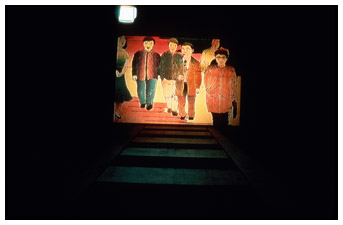


 |


launch interview with Tabaimo
Tabaimo mines familiar stereotypes of Japanese life--commuter trains, sushi, suicidal students, and overworked businessmen--to create poignant, surreal, and hilarious animated installations. Like other talented satiric commentators in the art world, including William Kentridge and Yoko Ono, Tabaimo possesses an insightful eye, a quick wit, and a facility with the truth. In addition to this, she seems to possess a deep affection for her subject matter and a sense of belonging to the community she lampoons. In an artist's statement, she wrote, "I have experienced the feeling of the word normal more passionately than any other person. I believe my thinking is exactly the same as others around me. It is through these views that I have produced my artistic concept." An exceptional student, who felt that she was blessed, Tabaimo later realized that she was ultimately just like everybody else. She embraced this realization and the accompanying sense of normalcy, even mundanity, and used it to channel an ironically idiosyncratic view of contemporary life, both in Japan and elsewhere.
Her moving tableaux, such as Japanese Zebra Crossing (1999), place the viewer in familiar "Japanese" places (a commuter train, a kitchen, a communal bath), making us a part of the cartoon universes unfolding around us. Illustrated in a low-tech style reminiscent of ukiyo-e and presented in a complex multiprojector format, her films are both technologically sophisticated and handmade. This aesthetic appears to connect our new hyper-speed global world with the modern one of the latter part of the previous century.
The winner of the prestigious Kirin Contemporary Award in 1999, Tabaimo has had solo exhibitions in Japan at the Kirin Plaza in Osaka; Gallery 16 in Kyoto; and Gallery Iteza, Kyoto. She was a participant in the 2001 Yokohama Triennale, Japan, and in the exhibition IKIRO/Be Alive: Contemporary Art from Japan 1980 to the Present (2001) at the Kröller-Müller Museum in Otterlo, The Netherlands. Like many contemporary artists who work with moving images, she has participated in a number of international film festivals, including Images Festival of Independent Film and Video, The Netherlands (2002) and Canada (2001), and Oberhausen International Short Film Festival, Germany (2000).
--Aimee Chang











